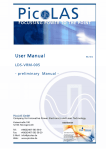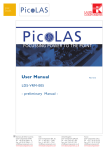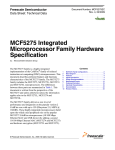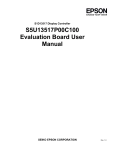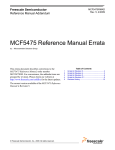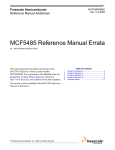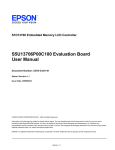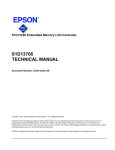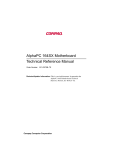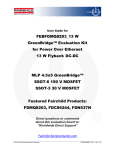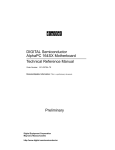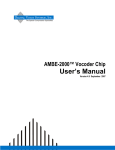Download S5U13515P00C100 Evaluation Board User Manual - Digi-Key
Transcript
S2D13515 Display Controller S5U13515P00C100 Evaluation Board User Manual SEIKO EPSON CORPORATION Rev 1.1 NOTICE No part of this material may be reproduced or duplicated in any form or by any means without the written permission of Seiko Epson. Seiko Epson reserves the right to make changes to this material without notice. Seiko Epson does not assume any liability of any kind arising out of any inaccuracies contained in this material or due to its application or use in any product or circuit and, further, there is no representation that this material is applicable to products requiring high level reliability, such as, medical products. Moreover, no license to any intellectual property rights is granted by implication or otherwise, and there is no representation or warranty that anything made in accordance with this material will be free from any patent or copyright infringement of a third party. This material or portions thereof may contain technology or the subject relating to strategic products under the control of the Foreign Exchange and Foreign Trade Law of Japan and may require an export license from the Ministry of International Trade and Industry or other approval from another government agency. All other product names mentioned herein are trademarks and/or registered trademarks of their respective companies. ©SEIKO EPSON CORPORATION 2008 - 2009, All rights reserved. Table of Contents Chapter 1 Introduction . . . . . . . . . . . . . . . . . . . . . . . . . . . . . . . . . . . . 5 Chapter 2 Features . . . . . . . . . . . . . . . . . . . . . . . . . . . . . . . . . . . . . . 6 Chapter 3 Installation and Configuration 3.1 CNF[7:0] Configuration Inputs . . . 3.1.1 CNF[2:0] . . . . . . . . . . . 3.1.2 CNF[7:3] . . . . . . . . . . . 3.1.3 Host Interface Configuration . 3.2 Configuration Jumpers . . . . . . . . . . . . . . . . . . . . . . . . . . . . . . . . . . . . . . . . . . . . . . . . . . . . . . . . . . . . . . . . . . . . . . . . . . . . . . . . . . . . . . . . . . . . . 7 .7 . 7 . 8 . 9 10 Chapter 4 Technical Description . . . . . . . . . . . . . . . . . . . . . 4.1 Power . . . . . . . . . . . . . . . . . . . . . . . . . . 4.1.1 Power Requirements . . . . . . . . . . . . . . . . . . . . . . . . 4.1.2 Voltage Regulators . . . . . . . . . . . . . . . . . . . . . . . . . 4.1.3 S2D13515 Power . . . . . . . . . . . . . . . . . . . . . . . . . . 4.1.4 LCD Backlight Power . . . . . . . . . . . . . . . . . . . . . . . . 4.2 Clocks . . . . . . . . . . . . . . . . . . . . . . . . . . 4.3 Reset . . . . . . . . . . . . . . . . . . . . . . . . . . . 4.4 Memory . . . . . . . . . . . . . . . . . . . . . . . . . . 4.4.1 SDRAM . . . . . . . . . . . . . . . . . . . . . . . . . . . . . . . 4.4.2 Serial Flash Memory with SPI interface . . . . . . . . . . . . . . 4.5 Host Interface . . . . . . . . . . . . . . . . . . . . . . . 4.5.1 Direct Host Bus Interface Support . . . . . . . . . . . . . . . . . 4.5.2 Connecting to the Epson S5U13U00P00C100 USB Adapter Board 4.6 LCD Interface . . . . . . . . . . . . . . . . . . . . . . . 4.6.1 FP1IO Interface . . . . . . . . . . . . . . . . . . . . . . . . . . . 4.6.2 FP2IO Interface . . . . . . . . . . . . . . . . . . . . . . . . . . . 4.7 Camera / I2C Interface . . . . . . . . . . . . . . . . . . . . 4.8 Keypad Interface . . . . . . . . . . . . . . . . . . . . . . 4.9 I2S Interface . . . . . . . . . . . . . . . . . . . . . . . . 4.10 PWM Connector . . . . . . . . . . . . . . . . . . . . . . 4.11 C33 Debugger Port . . . . . . . . . . . . . . . . . . . . . 4.12 JTAG Interface . . . . . . . . . . . . . . . . . . . . . . . . . . . . . . . . . . . . . . . . . . . . . . . . . . . . . . . . . . . . . . . . . . . . . . . . . . . . . . . . . . . . . . . . . . . . . . . . . . . . . . . . . . . . . . . . . . . . . . . . . . . . . . . . . . . . . . . . . . . . . . . . . . . . . . . . . . . . . . . . . . . . . . . . . . . . . . . . . . . . . . . . . . . . . . . . . . . . . . . . . . . . . 15 15 15 15 15 15 16 16 17 17 17 17 17 18 19 19 19 20 21 22 23 24 25 Chapter 5 Parts List . . . . . . . . . . . . . . . . . . . . . . . . . . . . . . . . . . . . . . . . . . . . . . . . . . . . . . . . . . . . . . . . . . . . . . . . . . . . . . . . . . . . . . . . . . . . . . . . . . . . . 26 Chapter 6 Schematic Diagrams . . . . . . . . . . . . . . . . . . . . . . . . . . . . . . 29 Chapter 7 Board Layout . . . . . . . . . . . . . . . . . . . . . . . . . . . . . . . . . . 34 S5U13515P00C100 Evaluation Board User Manual (Rev 1.1) EPSON 3 Chapter 8 References . . . . . . . . . . . . . . . . . . . . . . . . . . . . . . . . . . . .36 8.1 Documents . . . . . . . . . . . . . . . . . . . . . . . . . . . . . . . .36 8.2 Document Sources . . . . . . . . . . . . . . . . . . . . . . . . . . . . .36 4 EPSON S5U13515P00C100 Evaluation Board User Manual (Rev 1.1) Chapter 1 Introduction Chapter 1 Introduction This manual describes the setup and operation of the S5U13515P00C100 Evaluation Board. The evaluation board is designed as an evaluation platform for the S2D13515 Display Controller. The S5U13515P00C100 evaluation board can be used with many native platforms via the host connector which provides the appropriate signals to support a variety of CPUs. The S5U13515P00C100 evaluation board can also connect to the S5U13U00P00C100 USB Adapter board so that it can be used with a laptop or desktop computer, via USB 2.0. This user manual is updated as appropriate. Please check the Epson Research and Development Website at www.erd.epson.com for the latest revision of this document before beginning any development. We appreciate your comments on our documentation. Please contact us via email at [email protected]. S5U13515P00C100 Evaluation Board User Manual (Rev 1.1) EPSON 5 Chapter 2 Features Chapter 2 Features The S5U13515P00C100 Evaluation Board includes the following features: • 256-pin PBGA S2D13515 Display Controller • On-board SDRAM, configurable as 32MB (32-bit wide) or 16MB (16-bit wide) • On-board Serial Flash Memory, 32Mbit • Headers for connection to various Host Bus Interfaces (includes all S2D13515 Host Bus Interface signals) • Headers for connection to the S5U13U00P00C100 USB Adapter board • Headers for connection to various LCD panels (includes all S2D13515 FP1IO and FP2IO interface signals) • Header for connection to cameras • Header for I2S outputs • On-board 3x3 keypad • On-board 20MHz crystal • 14-pin DIP socket (if an oscillator for CLKI input is required) • 3.3V input power • On-board voltage regulator with 1.8V output • On-board voltage regulator with adjustable 12~25V output, 60~100mA max., to provide power for LED backlight of LCD panels. 6 EPSON S5U13515P00C100 Evaluation Board User Manual (Rev 1.1) Chapter 3 Installation and Configuration Chapter 3 Installation and Configuration The S5U13515P00C100 evaluation board incorporates a DIP switch, jumpers, and 0 ohm resistors which allow it to be used with a variety of different configurations. 3.1 CNF[7:0] Configuration Inputs The S2D13515 has 8 configuration inputs (CNF[7:0]), which can be configured through a combination of a DIP switch and 0 ohm resistors. CNF[2:0] are dedicated inputs and are configured using DIP switch SW1. CNF[7:3] are multiplexed with some host interface signals and are configured by 0 ohm resistors. 3.1.1 CNF[2:0] CNF[2:0] are configured using DIP switch SW1 as described below. Table 3-1: CNF[2:0] Configuration Settings CNF[2:0] CNF2 CNF1 CNF0 1 (connected to HIOVDD) 0 (connected to VSS) CNF[2:1] are used in combination with CNF[7:3] to select the host bus interface. For a summary of the possible host bus interfaces, see Section Table 3-3 :, “Host Interface Configuration Settings” on page 9. OSCI is the source for Input Clock 1 CLKI is the source for Input Clock 1 = suggested settings The following figure shows the location of DIP switch SW1 on the S5U13515P00C100 evaluation board. Figure 3-1: Configuration DIP Switch (SW1) Location S5U13515P00C100 Evaluation Board User Manual (Rev 1.1) EPSON 7 Chapter 3 Installation and Configuration 3.1.2 CNF[7:3] CNF[7:3] are configured using 0 Ohm resistors as described below. Table 3-2: CNF[7:3] Configuration Settings CNF Pin 1 (connected to HIOVDD) 0 (connected to VSS) TEA# R100 populated R107 not populated R100 not populated R107 populated AB0 R99 populated R106 not populated R99 not populated R106 populated CNF4 BDIP# R95 populated R102 not populated R95 not populated R102 populated CNF5 BURST# R96 populated R103 not populated R96 not populated R103 populated AB3 R98 populated R105 not populated R98 not populated R105 populated BE1# R97 populated R104 not populated R97 not populated R104 populated AB0 R99 populated R106 not populated R99 not populated R106 populated AB4 R101 populated R108 not populated R101 not populated R108 populated CNF3 (see Note) CNF6 (see Note) CNF7 = default settings, required settings when using S5U13U00P00C100 USB Adapter Board Note CNF3 and CNF6 are mapped to different pins depending on the combination of the other CNF inputs. The following figure shows the location of the 0 Ohm resistors used to configure CNF[7:3]. Figure 3-2: CNF[7:3] 0 Ohm Resistor Locations 8 EPSON S5U13515P00C100 Evaluation Board User Manual (Rev 1.1) Chapter 3 Installation and Configuration 3.1.3 Host Interface Configuration The host bus interface used by the S5U13515P00C100 evaluation board is selected using a combination of the CNF[2:1] pins and unused host interface pins. Many host bus interfaces have unused pins that can be used as configuration pins (CNF[7:3]) to select the host bus interface. The following table summarizes the available settings. Table 3-3 : Host Interface Configuration Settings CNF1 0 0 0 0 0 0 0 0 0 0 0 0 0 0 0 0 0 0 0 0 0 0 0 0 0 0 0 0 0 1 1 1 1 CNF2 0 0 0 0 0 0 0 1 1 1 1 1 1 1 0 0 0 0 0 0 0 1 1 1 1 1 1 1 1 0 0 1 1 X CNF3 0 (TEA#) 0 (TEA#) 0 (TEA#) 0 (TEA#) 0 (TEA#) 0 (TEA#) 0 (TEA#) 0 (TEA#) 0 (TEA#) 0 (TEA#) 0 (TEA#) 0 (TEA#) 0 (TEA#) 0 (TEA#) 1 (TEA#) 1 (TEA#) 1 (TEA#) 1 (TEA#) 1 (TEA#) 1 (TEA#) 1 (TEA#) 1 (TEA#) 1 (TEA#) 1 (TEA#) 1 (TEA#) 1 (TEA#) 1 (TEA#) 1 (TEA#) 1 (TEA#) 0 (AB0) 1 (AB0) 0 (BE1#) 1 (BE1#) CNF4 0 (BDIP#) 0 (BDIP#) 0 (BDIP#) 0 (BDIP#) 1 (BDIP#) 1 (BDIP#) 1 (BDIP#) 0 (BDIP#) 0 (BDIP#) 0 (BDIP#) 0 (BDIP#) 1 (BDIP#) 1 (BDIP#) 1 (BDIP#) 0 (BDIP#) 0 (BDIP#) 0 (BDIP#) 0 (BDIP#) 1 (BDIP#) 1 (BDIP#) 1 (BDIP#) 0 (BDIP#) 0 (BDIP#) 0 (BDIP#) 0 (BDIP#) 0 (BDIP#) 1 (BDIP#) 1 (BDIP#) 1 (BDIP#) X X X X CNF5 0 (BURST#) 0 (BURST#) 1 (BURST#) 1 (BURST#) 0 (BURST#) 0 (BURST#) 1 (BURST#) 0 (BURST#) 0 (BURST#) 1 (BURST#) 1 (BURST#) 0 (BURST#) 0 (BURST#) 1 (BURST#) 0 (BURST#) 0 (BURST#) 1 (BURST#) 1 (BURST#) 0 (BURST#) 0 (BURST#) 1 (BURST#) 0 (BURST#) 0 (BURST#) 1 (BURST#) 1 (BURST#) 1 (BURST#) 0 (BURST#) 0 (BURST#) 1 (BURST#) X X X X CNF6 0 (AB3) 1 (AB3) 1 (AB3) 1 (AB3) 0 (AB3) 1 (AB3) 0 (AB3) 0 (AB3) 1 (AB3) 1 (AB3) 1 (AB3) 0 (AB3) 1 (AB3) 0 (AB3) 0 (BE1#) 1 (BE1#) 1 (BE1#) 1 (BE1#) 0 (BE1#) 1 (BE1#) 0 (BE1#) 0 (AB0) 1 (AB0) 0 (AB0) 1 (AB0) 1 (AB0) 0 (AB0) 1 (AB0) 0 (AB0) X X X X CNF7 X X 0 (AB4) 1 (AB4) X X X X X 0 (AB4) 1 (AB4) X X X X X 0 (AB4) 1 (AB4) X X X X X X 0 (AB4) 1 (AB4) X X X X X X X Host Interface Indirect, 8-bit, Intel80 Type1 Indirect, 8-bit, Intel80 Type2 SPI I2C Indirect, 8-bit, NEC V850 Type1 Indirect, 8-bit, NEC V850 Type2 Indirect, 8-bit, Renesas SH4 Indirect, 16-bit, Intel80 Type1 Indirect, 16-bit, Intel80 Type2 SPI (2-stream) I2C Indirect, 16-bit, NEC V850 Type1 Indirect, 16-bit, NEC V850 Type2 Indirect, 16-bit, Renesas SH4 Direct, 8-bit, Intel80 Type1 Direct, 8-bit, Intel80 Type2 SPI I2C Direct, 8-bit, NEC V850 Type1 Direct, 8-bit, NEC V850 Type2 Direct, 8-bit, Renesas SH4 Direct, 16-bit, Intel80 Type1 Direct, 16-bit, Intel80 Type2 Direct, 16-bit, Intel PXA3xxs SPI I2C Direct, 16-bit, NEC V850 Type1 Direct, 16-bit, NEC V850 Type2 Direct, 16-bit, Renesas SH4 Indirect, 16-bit, TI EBI Direct, 16-bit, TI EBI Indirect, 16-bit, MPC555 Direct, 16-bit, MPC555 = default settings, required settings when using S5U13U00P00C100 USB Adapter Board = don’t care S5U13515P00C100 Evaluation Board User Manual (Rev 1.1) EPSON 9 Chapter 3 Installation and Configuration 3.2 Configuration Jumpers The S5U13515P00C100 has 16 jumpers which configure various evaluation board settings. The jumper positions for each function are shown below. Table 3-4: Configuration Jumper Settings Jumper Function Position 1-2 Position 2-3 No Jumper JP1 COREVDD Normal — COREVDD current measurement JP2 PLL1VDD Normal — PLL1VDD current measurement JP3 PLL2VDD Normal — PLL2VDD current measurement JP4 OSCVDD Normal — OSCVDD current measurement JP5 PIO1VDD Normal — PIO1VDD current measurement JP6 HIOVDD Normal — HIOVDD current measurement JP7 HIOVDD Source H4 connector, pin 31 3.3VDD — JP8 PIO1VDD Source H9 connector, pin 9 3.3VDD — JP9 PIO2VDD Source H9 connector, pin 10 3.3VDD — JP10 CM1VDD Normal — CM1VDD current measurement JP11 PIO2VDD Normal — PIO2VDD current measurement JP12 CM1DD Source H9 connector, pin 8 3.3VDD — JP13 IOVDD Source H9 connector, pin 7 3.3VDD — JP14 IOVDD Normal — IOVDD current measurement JP15 SDVDD Normal — SDVDD current measurement JP16 SDRAM Width Select (see Note) 32-bit wide SDRAM 16-bit wide SDRAM — = Required settings when using S5U13U00P00C100 USB Adapter board 10 EPSON S5U13515P00C100 Evaluation Board User Manual (Rev 1.1) Chapter 3 Installation and Configuration JP1, JP2, JP3, JP4, JP5, JP6, JP10, JP11, JP14, JP15 - Power Supplies for the S2D13515 JP1, JP2, JP3, JP4, JP5, JP6, JP10, JP11, JP14, and JP15 can be used to measure the current consumption of each S2D13515 power supply. When the jumper is at position 1-2, normal operation is selected. When no jumper is installed, the current consumption for each power supply can be measured by connecting an ammeter to pin 1 and 2 of the jumper. The jumper associated with each power supply is as follows: JP1 for COREVDD JP3 for PLL2VDD JP5 for PIO1VDD JP10 for CM1VDD JP14 for IOVDD JP2 for PLL1VDD JP4 for OSCVDD JP6 for HIOVDD JP11 for PIO2VDD JP15 for SDVDD Figure 3-3: Configuration Jumper Locations (JP1, JP2, JP3, JP4, JP5, JP6, JP10, JP11, JP14, JP15) S5U13515P00C100 Evaluation Board User Manual (Rev 1.1) EPSON 11 Chapter 3 Installation and Configuration JP7 - HIOVDD Source JP7 is used to select the source for the HIOVDD supply voltage. When the jumper is at position 1-2, the HIOVDD voltage must be provided to pin 31 on the H4 connector. When the jumper is at position 2-3, the HIOVDD voltage is provided by the 3.3V power supply of the board. Figure 3-4: Configuration Jumper Location (JP7) JP8 - PIO1VDD Source JP8 is used to select the source for the PIO1VDD supply voltage. When the jumper is at position 1-2, the PIO1VDD voltage must be provided to pin 9 on the H9 connector. When the jumper is at position 2-3, the PIO1VDD voltage is provided by the 3.3V power supply of the board. Figure 3-5: Configuration Jumper Location (JP8) 12 EPSON S5U13515P00C100 Evaluation Board User Manual (Rev 1.1) Chapter 3 Installation and Configuration JP9 - PIO2VDD Source JP9 is used to select the source for the PIO2VDD supply voltage. When the jumper is at position 1-2, the PIO2VDD voltage must be provided to pin 10 on the H9 connector. When the jumper is at position 2-3, the PIO2VDD voltage is provided by the 3.3V power supply of the board. Figure 3-6: Configuration Jumper Location (JP9) JP12 - CM1VDD Source JP12 is used to select the source for the CM1VDD supply voltage. When the jumper is at position 1-2, the CM1VDD voltage must be provided to pin 8 on the H9 connector. When the jumper is at position 2-3, the CM1VDD voltage is provided by the 3.3V power supply of the board. Figure 3-7: Configuration Jumper Location (JP12) S5U13515P00C100 Evaluation Board User Manual (Rev 1.1) EPSON 13 Chapter 3 Installation and Configuration JP13 - IOVDD Source JP13 is used to select the source for the IOVDD supply voltage. When the jumper is at position 1-2, the IOVDD voltage must be provided to pin 7 on the H9 connector. When the jumper is at position 2-3, the IOVDD voltage is provided by the 3.3V power supply of the board. Figure 3-8: Configuration Jumper Location (JP13) JP16 - SDRAM Width Select JP16 is used to select the bus width of the external SDRAM. When the jumper is at position 1-2, the external SDRAM is 32 bits wide and the memory size is 32M bytes. In this configuration, the memory consists of 2 chips in parallel, each16M bytes and 16 bits wide. When the jumper is at position 2-3, the external SDRAM is 16 bits wide and the memory size is 16M bytes. In this configuration, one memory chip is disabled and only one chip is active (16M bytes and 16 bits wide). Figure 3-9: Configuration Jumper Location (JP16) 14 EPSON S5U13515P00C100 Evaluation Board User Manual (Rev 1.1) Chapter 4 Technical Description Chapter 4 Technical Description 4.1 Power 4.1.1 Power Requirements The S5U13515P00C100 evaluation board requires an external regulated power supply (3.3V / 1A). The power is supplied to the evaluation board through pin 33 of the H4 header, or pin 5 of the P2 header. The green LED “3.3V Power” is turned on when 3.3V power is applied to the board. 4.1.2 Voltage Regulators The S5U13515P00C100 evaluation board has an on-board linear regulator to provide the 1.8V power required by the S2D13515 Display Controller. It also has a step-up switching voltage regulator to generate adjustable 12~25V, which can be used to power the LED backlight on some LCD panels. 4.1.3 S2D13515 Power The S2D13515 Display Controller requires 1.8V power and 2.3~2.7V or 3.0~3.6V power. COREVDD, PLL1VDD, PLL2VDD, and OSCVDD require 1.8V power which is provided by an on-board linear voltage regulator. HIOVDD, PIO1VDD, PIO2VDD, CM1VDD, and IOVDD input power may be in the range 2.3V~2.7V or 3.0V~3.6V. When JP7, JP8, JP9, JP12, or JP13 are set to the 2-3 position, the corresponding power input is connected to 3.3V. If a different voltage is required, set the corresponding jumper to the 1-2 position and connect the external power supply to the evaluation board as indicated in Table 3-4: “Configuration Jumper Settings,” on page 10. SDVDD input power may be in the range 2.3V~2.7V or 3.0V~3.6V. On the evaluation board, SDVDD is connected to 3.3V. 4.1.4 LCD Backlight Power On the evaluation board there is an adjustable 12~25V power supply. At 12V, the maximum current available is 100mA. At 25V, the maximum current available is 60mA. This power supply is intended for use to power the LED backlight on some LCD panels. The voltage is adjusted by the R175 pot. Note For LCD panels that use a CCFL backlight, an external power supply must be used to provide power to the inverter for the CCFL backlight. Usually, the inverter current consumption is higher than the maximum 100mA current available from the on-board voltage regulator. S5U13515P00C100 Evaluation Board User Manual (Rev 1.1) EPSON 15 Chapter 4 Technical Description 4.2 Clocks The clock for the S2D13515 Display Controller is provided by a 20MHz crystal connected to the OSCI and OSCO pins. Additionally, the S5U13515P00C100 evaluation board can also use an oscillator if the DIP14 footprint is populated. If populated, the oscillator is connected to the CLKI input clock of the S2D13515 Display controller. Note For details on the S2D13515 clock structure, refer to the S2D13515 Hardware Functional Specification, document number X83A-A-001-xx. 4.3 Reset The S2D13515 Display Controller on the S5U13515P00C100 evaluation board can be reset using a push-button switch (SW2), or via an active low reset signal from the host development platform (pin 30 on the H4 connector). Figure 4-1: Reset Switch (SW2) Location 16 EPSON S5U13515P00C100 Evaluation Board User Manual (Rev 1.1) Chapter 4 Technical Description 4.4 Memory 4.4.1 SDRAM The S5U13515P00C100 evaluation board has 2 SDRAM ICs, each 128Mbit x16-bit, CL=2 in a TSOP54 package. When the S2D13515 Display Controller is configured for 32-bit wide DRAM bus, both SDRAM ICs are used. When the S2D13515 Display Controller is configured for 16-bit wide DRAM bus, only one of the SDRAM ICs is used and the other SDRAM ICs is disabled by having its chip select input pulled high to inactive state, by putting jumper JP16 in 2-3 position. 4.4.2 Serial Flash Memory with SPI interface The S2D13515 Display Controller has a SPI Flash Memory interface which is connected to a 32Mbit Flash EPROM. 4.5 Host Interface 4.5.1 Direct Host Bus Interface Support All S2D13515 host interface pins are available on connectors H3 and H4. This allows the S5U13515P00C100 evaluation board to be connected to a variety of development platforms. For S2D13515 host interface pin mapping, refer to the S2D13515 Hardware Functional Specification, document number X83A-A-001-xx. The following figure shows the location of host bus connectors H3 and H4. H3 is a 0.1” x 0.1” 40-pin header (20x2) and H4 is a 0.1” x 0.1” 34-pin header (17 x 2). Figure 4-2: Host Bus Connector Location (H3 and H4) For the pinout of connectors H3 and H4, see Section Chapter 6, “Schematic Diagrams” on page 29. S5U13515P00C100 Evaluation Board User Manual (Rev 1.1) EPSON 17 Chapter 4 Technical Description 4.5.2 Connecting to the Epson S5U13U00P00C100 USB Adapter Board The S5U13515P00C100 evaluation board is designed to connect to a S5U13U00P00C100 USB Adapter Board. The USB adapter board provides a simple connection to any computer via a USB 2.0 connection. The S5U13515P00C100 directly connects to the USB adapter board through connectors P1 and P2. The USB adapter board also supplies the 3.3V power required by the S5U13515P00C100 evaluation board. HIOVDD should be configured for 3.3V and JP7 should be set to the 2-3 position. When the S5U13515P00C100 is connected to the S5U13U00P00C100 USB Adapter board, there are 2 LEDs on the S5U13515P00C100 which provide a quick visual status of the USB adapter. LED1 blinks to indicate that the USB adapter board is active. LED2 turns on to indicate that the USB has been enumerated by the PC. The following diagram shows the location of connectors P1 and P2. P1 and P2 are 2mm x 2mm, 40-pin headers (20 x 2) located on the underside of the board. Figure 4-3: USB Adapter Connector Locations (P1 and P2) For the pinout of connectors P1 and P2, see Section Chapter 6, “Schematic Diagrams” on page 29. Note A windows driver must be installed on the PC when the S5U13515P00C100 is used with the S5U13U00P00C100 USB Adapter Board. The S1D13xxxUSB driver is available at www.erd.epson.com. 18 EPSON S5U13515P00C100 Evaluation Board User Manual (Rev 1.1) Chapter 4 Technical Description 4.6 LCD Interface The LCD interface uses the FP1IO[23:0] and FP2IO[27:0] pins. All signals on these pins are available on connectors H5, H6, and H7. Connectors H5, H6, and H7 are 0.1” x 0.1”, 40-pin headers (20 x 2). The following diagram shows the location of these connectors. Figure 4-4: FP1IO and FP2IO Connectors Location (H5, H6, H7) For the pinout of connectors H5, H6, and H7, see Section Chapter 6, “Schematic Diagrams” on page 29. 4.6.1 FP1IO Interface The FP1IO interface signals have multiplexed functions. All FP1IO interface signals, except FP1IO18 and FP1IO19, are available on connector H6. FP1IO18 and FP1IO19 signals go through 0 ohm resistors and are available on connector H7. The FP1IO interface can be configured as a LCD interface, 18-bit RGB input stream interface, or 8-bit YUV camera interface and keyboard interface. For S2D13515 FP1IO interface pin mapping, refer to the S2D13515 Hardware Functional Specification, document number X83A-A-001-xx. 4.6.2 FP2IO Interface All FP2IO interface signals are available on connectors H5 and H7. For S2D13515 FP2IO interface pin mapping, refer to the S2D13515 Hardware Functional Specification, document number X83A-A-001-xx. S5U13515P00C100 Evaluation Board User Manual (Rev 1.1) EPSON 19 Chapter 4 Technical Description 4.7 Camera / I2C Interface The S2D13515 Display Controller has a Camera interface. All the camera interface signals are available on connector H10. To control the camera, the S2D13515 Display Controller has an I2C master interface. The SDA and SCL signals are pulled high to CM1VDD by 2.2 kΩ resistors and are available on connector H10. The reset signal provided on H10 is active low and is pulled to HIOVDD when inactive. Connector H10 is a 0.1” x 0.1”, 20-pin header (10 x 2). The following figure shows the location of the connector H10. Figure 4-5: Camera Connector Location (H10) For the pinout of connector H10, see Section Chapter 6, “Schematic Diagrams” on page 29. 20 EPSON S5U13515P00C100 Evaluation Board User Manual (Rev 1.1) Chapter 4 Technical Description 4.8 Keypad Interface Note The keyboard is non-operational with the buttons SW3-SW11, mounted as they are on the board. In order to make the keyboard operational, the user must remove the buttons SW3-SW11 from the board and mount them back on the board, but rotated by 90 degrees or 270 degrees. The buttons will not match the footprint on the PCB, but this is how they must be mounted on the board. The S2D13515 Display Controller can support up to a 5x5 matrix keypad, but the S5U13515P00C100 evaluation board includes only a 3x3 keypad. The keypad interface can be configured to use either the FPIO1 interface or Host interface pins. For S2D13515 pin mapping, refer to the S2D13515 Hardware Functional Specification, document number X83A-A-001-xx. The keypad interface is configured for either the FPIO1 interface or Host Interface pins using 0 ohm resistors. M/R#, AB[20:19], AB[16:14] S2D13515 FP1IO[23:20], FP1IO[16:15] Zero Ohms 3x3 Keypad Zero Ohms Figure 4-6: Keypad Interface Zero Ohm Resistor Overview Diagram The keypad can be configured to connect to 1 of 2 source pins on the S2D13515. Depending of the configuration, the input lines must be pulled high to corresponding power supply. The source connection for the keypad is determined by populating the correct set of zero ohm resistors as described below. Table 4-1: Keypad Zero Ohm Resistor Summary Keypad Pin Function KBR0 KBR1 KBR2 KBC0 KBC1 KBC2 Power (HIOVDD or PIO1VDD) Populate only 1 set of the zero ohm resistors below Zero Ohm For FP1IO Zero Ohm For Host Interface R191 R185 R192 R186 R193 R187 R194 R188 R195 R190 R196 R189 R181 R180 S5U13515P00C100 evaluation board comes configured with the keyboard interface from the Host Interface pins, so resistors R185 ~ R190 and R180 are populated and R191 ~ R196 and R181 are not populated. S5U13515P00C100 Evaluation Board User Manual (Rev 1.1) EPSON 21 Chapter 4 Technical Description 4.9 I2S Interface The S2D13515 Display Controller has an I2S Audio output interface. All of the I2S interface signals are available on connector H8. The I2C signals, available on the same connector, can be used to program an external I2S Audio DAC IC. Connector H8 is a 0.1” x 0.1”, 24-pin header (12x2). The following figure shows the location of the connector H8. Figure 4-7: I2S Connector Location (H8) For the pinout of connector H8, see Section Chapter 6, “Schematic Diagrams” on page 29. 22 EPSON S5U13515P00C100 Evaluation Board User Manual (Rev 1.1) Chapter 4 Technical Description 4.10 PWM Connector The S2D13515 Display Controller has two PWM outputs which are available on connector H9. The other pins on connector H9 are used to connect the external power supplies to CM1VDD, IOVDD, PIO1VDD, and PIO2VDD, if a voltage level different than 3.3V is required. Note that connector H9 is not populated on the S5U13515P00C100 evaluation board. Connector H9 is a 0.1” x 0.1”, 10-pin header (5x2). The following figure shows the location of the connector H9. Figure 4-8: PWM Connector Location (H9) For the pinout of connector H9, see Section Chapter 6, “Schematic Diagrams” on page 29. S5U13515P00C100 Evaluation Board User Manual (Rev 1.1) EPSON 23 Chapter 4 Technical Description 4.11 C33 Debugger Port The S2D13515 contains an embedded C33 microprocessor core. The debug monitor interface is available on connector H2 for firmware debugging using C33 Debugger. In order to use connector H2, zero ohm resistors must be configured depending on the desired S2D13515 configuration. The C33 debugger function can be sourced from 2 sets of the host interface pins or from a set of FP2IO pins. S2D13515 AB[11:7], AB6 or BS# Zero Ohms FP2IO[17, 16, 14, 13, 11, 10] Zero Ohms DB[13:8] Zero Ohms H2 C33 Debugger Port Figure 4-9: C33 Debugger Zero Ohm Resistor Overview Diagram The connection to the C33 Debugger port is determined by populating the correct set of zero ohm resistors as described below. Table 4-2: C33 Debugger Port H7 Zero Ohm Selection Populate only 1 set of the zero ohm resistors below C33 Pin Function C33 Debugger port from FP2IO pins C33 Debugger port from AB[11:7], AB6 or BS# pins C33 Debugger port from DB[13:8] pins PEDST0 R74 populated R210 not populated R65 populated R202 not populated R80 populated R208 not populated PEDST1 R73 populated R211 not populated R66 populated R201 not populated R79 populated R207 not populated PEDST2 R72 populated R212 not populated R67 populated R200 not populated R78 populated R206 not populated PEDCLK R70 populated R213 not populated R69 populated R199 not populated R76 populated R205 not populated PEDSIO R71 populated R215 not populated R68 populated R198 not populated R77 populated R204 not populated PEDCPCO R75 populated R214 not populated R63 populated (from AB6) R64, R197 not populated R64 populated (from BS#) R63, R209 not populated R81 populated R203 not populated S5U13515P00C100 board comes configured for the C33 Debugger port from the Host Interface AB[11:6] pins, so resistors R63, R65 ~ R69 are populated and R197 ~ R202 are not populated, R203 ~ R215 are populated and R64, R70 ~ R81 are not populated. 24 EPSON S5U13515P00C100 Evaluation Board User Manual (Rev 1.1) Chapter 4 Technical Description Connector H2 is a 0.1” x 0.1”, 10-pin header (5x2). The following figure shows the location of the connector H2. Figure 4-10: C33 Debugger Connector Location (H2) For the pinout of connector H2, see Section Chapter 6, “Schematic Diagrams” on page 29. 4.12 JTAG Interface The S2D13515 Display Controller has a JTAG interface. All the JTAG signals are available on connector H1. Note that connector H1 is not populated on the S5U13515P00C100 evaluation board. Connector H1 is a 0.1” x 0.1”, 12-pin header (6x2). The following figure shows the location of the connector H1. Figure 4-11: JTAG Connector Location (H1) For the pinout of connector H1, see Section Chapter 6, “Schematic Diagrams” on page 29. S5U13515P00C100 Evaluation Board User Manual (Rev 1.1) EPSON 25 Chapter 5 Parts List Chapter 5 Parts List Table 5-1 : S5U13515P00C100 Parts List Item Quantity Reference Part Description 50 C1,C2,C3,C4,C5,C6,C7,C 8,C17,C20,C24,C25,C26, C27,C28,C29,C30,C31,C3 9,C40,C41,C42,C43,C49, C50,C51,C52,C53,C54,C5 5,C63,C67,C69,C71,C72, C74,C75,C76,C77,C78,C7 9,C80,C81,C82,C83,C84, C85,C86,C87,C106 0.1uF Yageo America 04022F104Z7B20D, C0402 2 43 C9,C10,C11,C12,C13,C14 ,C15,C16,C23,C32,C33,C 34,C35,C36,C37,C38,C44, C45,C46,C47,C48,C56,C5 7,C58,C59,C60,C61,C62, C68,C88,C89,C90,C91,C9 2,C93,C94,C95,C96,C97, C98,C99,C100,C101 0.01uF Yageo America 0402ZRY5V7BB103, C0402 3 2 C18,C21 1nF Yageo America 04022R102K9B20D, C0402 4 5 C19,C22,C64,C70,C73 10uF Panasonic - ECG ECJ-CV50J106M, C0805 5 2 C65,C66 18pF Panasonic - ECG ECJ-0EC1H180J, C0402 6 1 C102 2.2uF 10V Taiyo Yuden LMK212BJ225KG-T, C0805, CAP CER 2.2UF 10V X7R 0805 7 1 C103 10uF 35V Taiyo Yuden GMK325BJ106KN-T, C1210, CAP CER 10UF 35V X5R 1210 8 1 C104 150pF Panasonic - ECG ECJ-0EC1H151J, C0402 9 1 C105 1uF Panasonic - ECG ECJ-0EB0J105M, C0402 10 3 D1,D2,D3 11 10 D4,D5,D6,D7,D8,D9,D10, D11,D12,D13 MBR0540 Micro Commercial Co. MBR0540-TP, SOD-123, DIODE SCHOTTKY 40V 500MA SOD123 12 1 F1 ACH32C-333-T TDK ACH32C-333-T, FILTR 3TERM 10MHZ TO 300MHZ SMD 13 1 F2 ACF451832-222 TDK ACF451832-222, FILTER 3-TERM 60MHZ 300MA SMD 14 0 H1 JTAG Samtec TSW-106-07-G-D Do not populate 15 1 H2,H9 16 1 H3 HEADER_20X2 Samtec TSW-120-07-G-D 17 1 H4 HEADER_17X2 Samtec TSW-117-07-G-D 18 3 H5,H6,H7 19 1 H8 I2S PORT Samtec TSW-112-07-G-D 20 1 H10 CAMERA1 Samtec TSW-110-07-G-D 1 26 Panasonic - SSG LNJ308G8LRA, LED0603, LED GREEN SS TYPE LOW CUR SMD Samtec TSW-105-07-G-D, Do not populate H9 Samtec TST-120-01-G-D EPSON S5U13515P00C100 Evaluation Board User Manual (Rev 1.1) Chapter 5 Parts List Table 5-1 : S5U13515P00C100 Parts List Item Quantity Reference 21 10 JP1,JP2,JP3,JP4,JP5,JP6 JP10,JP11,JP14,JP15 SIP2 CONN HEADER VERT 2POS .100 TIN or GENERIC 22 6 JP7,JP8,JP9,JP12,JP13,J P16 SIP3 CONN HEADER VERT 3POS .100 TIN or GENERIC 23 6 L1,L2,L3,L4,L5,L6 Ferrite Steward HZ0603B751R-10, R0603, FERRITE 200MA 938 OHMS 0603 SMD 24 1 L7 10uH Panasonic - ECG ELL-6SH100M, IND_ELL6, COIL 10UH 1300MA CHOKE SMD 25 2 P1,P2 HEADER_20X2 3M 151240-8422-RB, HDR2X20/2MM 61 R1,R2,R3,R4,R5,R6,R7,R 8,R9,R10,R11,R12,R13,R 14,R15,R16,R17,R18,R19, R20,R21,R22,R23,R24,R2 5,R26,R27,R28,R29,R30, R31,R32,R33,R34,R35,R3 6,R37,R38,R39,R40,R41, R42,R43,R44,R45,R46,R4 7,R48,R49,R50,R51,R53, R54,R55,R57,R58,R59,R6 0,R61,R62,R88 33 1% R0402 0 R52,R64,R70,R71,R72,R7 3,R74,R75,R76,R77,R78, R79,R80,R81,R95,R96,R9 7,R98,R99,R100,R101,R1 04,R106,R108,R134,R135, R136,R137,R138,R139,R1 40,R141,R142,R143,R144, R145,R146,R147,R148,R1 49,R150,R151,R161,R163, R165,R167,R169,R170,R1 81,R191,R192,R193,R194, R195,R196,R197,R198,R1 99,R200,R201,R202,R216, R217,R218,R219 0_np R0402 Do not populate 28 68 R56,R63,R65,R66,R67,R6 8,R69,R83,R85,R86,R87, R102,R103,R105,R107,R1 09,R110,R111,R113,R114, R115,R116,R117,R118,R1 19,R120,R121,R122,R123, R124,R125,R126,R127,R1 28,R129,R130,R131,R132, R152,R153,R154,R155,R1 60,R162,R164,R166,R168, R171,R180,R185,R186,R1 87,R188,R189,R190,R203, R204,R205,R206,R207,R2 08,R209,R210,R211,R212, R213,R214,R215 0 R0402 29 1 R82 1M R0402 30 1 R84 1k R0402 26 27 Part S5U13515P00C100 Evaluation Board User Manual (Rev 1.1) EPSON Description 27 Chapter 5 Parts List Table 5-1 : S5U13515P00C100 Parts List Item 28 Quantity Reference Part Description 31 10 R89,R91,R92,R93,R94,R1 56,R174,R182,R183,R184 10k R0402 32 1 R90 150k 1% R0402 33 3 R112,R133,R172 0 R0603 34 3 R157,R158,R159 270 1% R0402 35 1 R173 120k R0402 36 1 R175 200k Panasonic - ECG EVN-5ESX50B25, POT 200K OHM 3MM CARBON TRIM SMD 37 1 R176 56k R0402 38 1 R177 13.3k 1% R0402 39 2 R178,R179 2.2k R0402 40 16 SH1,SH2,SH3,SH4,SH5,S H6,SH7,SH8,SH9,SH10,S H11,SH12,SH13,SH14,SH 15,SH16 .100 in. Jumper Shunt Sullins Electronics Corp. STC02SYAN JUMPER SHORTING TIN 41 1 SW1 SW4_DIPSW4 CTS Corp 218-4LPST, DIPSW4, SWITCH DIP HALF PITCH 4POS 42 10 SW2,SW3,SW4,SW5,SW6 ,SW7,SW8,SW9,SW10,S W11 SW TACT-SPST ITT Industries KSC201JLFS, SWITCH TACT SILVR 120GF J-LEAD 43 2 TPGND1,TP3.3VDD1 TP_SMT Keystone 5015, TP_1206, PC TEST POINT MINIATURE SMT 44 1 U1 S2D13515PBGA256 45 1 U2 M25P32-VMF ST Microelectronics M25P32-VMF6P, IC SRL FLASH 32MBIT 3V 16-SOIC 46 2 U3,U4 128M16 DRAM Qimonda HYB39S128160FE-7, IC SDRAM 128MBit 54-TSOP 47 1 U5 MIC37100-1.8WS Micrel MIC37100-1.8WS, SOT-223, Alternate MIC39100-1.8WS 48 1 U6 LM2733Y National Semiconductor LM2733YMF/NOPB, SOT23-5, IC CONV BOOST 40V FET SW SOT23-5 49 1 X1 MA-506 20.0000M Epson MA-506 20.0000M, CRYSTAL 20.0000MHZ 18PF SMD 50 0 Y1 14-Pin DIP AMP 2-641609-1 Do not populate EPSON S5U13515P00C100 Evaluation Board User Manual (Rev 1.1) A B C D 3 TMS TDI TDO TCK IOVDD 4 4 1 3 5 7 9 11 CM1DAT0 CM1DAT1 CM1DAT2 CM1DAT3 CM1DAT4 CM1DAT5 CM1DAT6 CM1DAT7 CM1FIELD CM1HREF CM1VREF CM1CLKIN CM1CLKOUT 5 5 5 5 5 5 5 5 5 5 5 5 5 JTAG H1 PWM1 PWM2 SCL SDA WSIO SCKIO SDO MCLKO 4 4 4 4 4,5 4,5 CNF0 CNF1 CNF2 SPICS# SPICLK SPIDIO 2 2 2 CLKI BUSCLK OSCI OSCO 2 3 2 2 2 2 2 CS# M/R# RD# RD/WR# BE0# BE1# BS# BURST# BDIP# TEA# WAIT# IRQ RESET# DB0 DB1 DB2 DB3 DB4 DB5 DB6 DB7 DB8 DB9 DB10 DB11 DB12 DB13 DB14 DB15 AB0 AB1 AB2 AB3 AB4 AB5 AB6 AB7 AB8 AB9 AB10 AB11 AB12 AB13 AB14 AB15 AB16 AB17 AB18 AB19 AB20 3 3,5 3 3 3 2,3 3 2,3 2,3 2,3 3 3 2,3,5 DB[15:0] AB[20:0] 2 4 6 8 10 12 R12 R14 R16 R209 R203 R204 R205 R206 R207 R208 R197 R198 R199 R200 R201 R202 5 TCK TMS TDI TDO 0_np 0 R56 pBS# pDB8 pDB9 pDB10 pDB11 pDB12 pDB13 pAB6 pAB7 pAB8 pAB9 pAB10 pAB11 R52 33 1% 33 1% 33 1% 0 0 0 0 0 0 0 0_np 0_np 0_np 0_np 0_np 0_np L14 A2 A4 K11 K12 L16 L15 K13 M13 M12 E8 D8 C3 C4 C5 C6 D5 A8 D7 E6 C8 F7 B8 B7 A7 N13 N15 N14 N16 M15 L12 L11 J10 K15 K16 B1 J1 A5 A6 L3 M1 M2 M3 M4 N1 M5 N2 N3 P2 P1 R1 R2 L1 K6 K2 K1 K3 K4 K5 J5 J2 J3 J6 J7 H1 H3 H4 H2 H6 H7 G2 G3 G4 G5 F1 F2 G6 G7 F3 F5 F6 E3 E4 D1 D2 E5 D3 D4 C1 TESTEN VCP1 VCP2 TCK TMS TDI TDO TRST PWM1 PWM2 SCL SDA CM1DAT0 CM1DAT1 CM1DAT2 CM1DAT3 CM1DAT4 CM1DAT5 CM1DAT6 CM1DAT7 CM1FIELD CM1HREF CM1VREF CM1CLKIN CM1CLKOUT WSIO SCKIO SDO MCLKO SPICS# SPICLK SPIDIO CNF0 CNF1 CNF2 CLKI BUSCLK OSCI OSCO CS# M/R# RD# RD/WR# BE0# BE1# BS# BURST# BDIP# TEA# WAIT# IRQ RESET# DB0 DB1 DB2 DB3 DB4 DB5 DB6 DB7 DB8 DB9 DB10 DB11 DB12 DB13 DB14 DB15 AB0 AB1 AB2 AB3 AB4 AB5 AB6 AB7 AB8 AB9 AB10 AB11 AB12 AB13 AB14 AB15 AB16 AB17 AB18 AB19 AB20 U1 C12 D6 E1 E16 L2 M16 N6 T12 COREVDD COREVDD COREVDD COREVDD COREVDD COREVDD COREVDD COREVDD B2 PLL1VDD PLL2 A3 PLL2VDD OSC HIO E2 G1 J4 L5 SDVDD S2D13515PBGA256 HIOVDD HIOVDD HIOVDD HIOVDD B5 OSCVDD A15 B10 D14 E11 F16 H14 SDVDD SDVDD SDVDD SDVDD SDVDD SDVDD PLL1 PIO1 4 4 PIO2 PLL2VSS CORE IO GND1 GND2 GND3 IOVDD FP2IO0 FP2IO1 FP2IO2 FP2IO3 FP2IO4 FP2IO5 FP2IO6 FP2IO7 FP2IO8 FP2IO9 FP2IO10 FP2IO11 FP2IO12 FP2IO13 FP2IO14 FP2IO15 FP2IO16 FP2IO17 FP2IO18 FP2IO19 FP2IO20 FP2IO21 FP2IO22 FP2IO23 FP2IO24 FP2IO25 FP2IO26 FP2IO27 FP1IO0 FP1IO1 FP1IO2 FP1IO3 FP1IO4 FP1IO5 FP1IO6 FP1IO7 FP1IO8 FP1IO9 FP1IO10 FP1IO11 FP1IO12 FP1IO13 FP1IO14 FP1IO15 FP1IO16 FP1IO17 FP1IO18 FP1IO19 FP1IO20 FP1IO21 FP1IO22 FP1IO23 R1 R2 R3 R4 R5 R6 R7 R8 R9 R10 R11 R13 R15 R17 R18 R19 R20 R21 R22 R23 R24 R25 R26 R27 R28 R29 R30 R31 R32 R33 R34 R35 R36 R37 R38 R39 R40 R41 R42 R43 R44 R45 R46 R47 R48 R49 R50 R51 R53 R54 R55 R57 R58 R59 R60 R61 R62 FP2IO[27:0] AB[20:0] 33 1% 33 1% 33 1% 33 1% 33 1% 33 1% 33 1% 33 1% 33 1% 33 1% 33 1% 33 1% 33 1% 33 1% 33 1% 33 1% 33 1% 33 1% 33 1% 33 1% 33 1% 33 1% 33 1% 33 1% 33 1% 33 1% 33 1% 33 1% 33 1% 33 1% 33 1% 33 1% 33 1% 33 1% 33 1% 33 1% 33 1% 33 1% 33 1% 33 1% 33 1% 33 1% 33 1% 33 1% 33 1% 33 1% 33 1% 33 1% 33 1% 33 1% 33 1% 33 1% 33 1% 33 1% 33 1% 33 1% 33 1% For Direct 8-bit Interface MEMDQ0 MEMDQ1 MEMDQ2 MEMDQ3 MEMDQ4 MEMDQ5 MEMDQ6 MEMDQ7 MEMDQ8 MEMDQ9 MEMDQ10 MEMDQ11 MEMDQ12 MEMDQ13 MEMDQ14 MEMDQ15 MEMDQ16 MEMDQ17 MEMDQ18 MEMDQ19 MEMDQ20 MEMDQ21 MEMDQ22 MEMDQ23 MEMDQ24 MEMDQ25 MEMDQ26 MEMDQ27 MEMDQ28 MEMDQ29 MEMDQ30 MEMDQ31 2 FP2IO[27:0] MEMA[12:0] 4,5 3 R70 R71 R72 R73 R74 R75 R76 R77 R78 R79 R80 R81 pFP2IO14 pFP2IO17 pFP2IO13 pFP2IO11 pFP2IO10 pFP2IO16 pDB10 pDB9 pDB11 pDB12 pDB13 pDB8 R63 R65 R66 R67 R68 R69 3 0_np 0_np 0_np 0_np 0_np 0_np 0_np 0_np 0_np 0_np 0_np 0_np 0 0 0 0 0 0 Signal traces must be less than 5cm. Place these resistors as close to U1 as possible. 2 2 2 2 2 2 MEMDQM0 MEMDQM1 MEMDQM2 MEMDQM3 MEMCLK MEMCKE pAB6 pAB11 pAB10 pAB9 pAB7 pAB8 2 2 2 2 2 2 MEMBA0 MEMBA1 MEMCS# MEMRAS# MEMCAS# MEMWE# MEMA0 MEMA1 MEMA2 MEMA3 MEMA4 MEMA5 MEMA6 MEMA7 MEMA8 MEMA9 MEMA10 MEMA11 MEMA12 0 0 0 0 pFP2IO16 R214 pFP2IO17 R215 pFP2IO13 R212 pFP2IO14 R213 FP2IO0 FP2IO1 FP2IO2 FP2IO3 FP2IO4 FP2IO5 FP2IO6 FP2IO7 FP2IO8 FP2IO9 FP2IO10 FP2IO11 FP2IO12 FP2IO13 FP2IO14 FP2IO15 FP2IO16 FP2IO17 FP2IO18 FP2IO19 FP2IO20 FP2IO21 FP2IO22 FP2IO23 FP2IO24 FP2IO25 FP2IO26 FP2IO27 FP1IO[23:0] 0 0 FP1IO0 FP1IO1 FP1IO2 FP1IO3 FP1IO4 FP1IO5 FP1IO6 FP1IO7 FP1IO8 FP1IO9 FP1IO10 FP1IO11 FP1IO12 FP1IO13 FP1IO14 FP1IO15 FP1IO16 FP1IO17 FP1IO18 FP1IO19 FP1IO20 FP1IO21 FP1IO22 FP1IO23 pFP2IO10 R210 pFP2IO11 R211 For Indirect Host Interface A9 B9 F8 C9 G8 D9 A10 E9 F15 G14 G15 H10 G16 H11 H12 J15 H15 H16 H13 C10 A11 E10 G9 C11 F11 B13 E12 B14 C14 B16 C16 D16 G10 F13 G11 D10 F9 B11 F10 D12 A13 C13 A14 D13 B15 C15 D15 E14 F12 F14 G12 J14 J13 J12 J11 A12 J16 P14 P16 P15 R15 R14 T15 M11 P13 N12 P12 K10 T13 R12 L10 N11 P11 T11 N10 K9 P10 R10 L9 M9 T10 P9 R9 K8 T9 L8 M8 P8 R8 P7 R7 T7 N7 M7 L7 K7 T3 R6 R5 P4 M6 L6 R3 T2 P3 P5 N5 R4 T5 For REG[001Ch] bit 0 = 1b, C33 debug pins on FP2IO MEMA0 MEMA1 MEMA2 MEMA3 MEMA4 MEMA5 MEMA6 MEMA7 MEMA8 MEMA9 MEMA10 MEMA11 MEMA12 MEMBA0 MEMBA1 MEMCS# MEMRAS# MEMCAS# MEMWE# MEMDQ0 MEMDQ1 MEMDQ2 MEMDQ3 MEMDQ4 MEMDQ5 MEMDQ6 MEMDQ7 MEMDQ8 MEMDQ9 MEMDQ10 MEMDQ11 MEMDQ12 MEMDQ13 MEMDQ14 MEMDQ15 MEMDQ16 MEMDQ17 MEMDQ18 MEMDQ19 MEMDQ20 MEMDQ21 MEMDQ22 MEMDQ23 MEMDQ28 MEMDQ24 MEMDQ25 MEMDQ26 MEMDQ27 MEMDQ29 MEMDQ30 MEMDQ31 MEMDQM0 MEMDQM1 MEMDQM2 MEMDQM3 MEMCLK MEMCKE CM1 E7 CM1VDD N9 R11 R16 T14 PIO2VDD PIO2VDD PIO2VDD PIO2VDD M14 OSCVSS T4 T6 T8 PIO1VDD PIO1VDD PIO1VDD PLL1VSS B3 VSS VSS VSS VSS VSS VSS VSS VSS VSS VSS VSS VSS VSS VSS VSS VSS VSS VSS VSS VSS VSS VSS VSS VSS VSS A1 A16 B12 C2 C7 D11 E13 E15 F4 G13 H5 H8 H9 J8 J9 K14 L4 L13 M10 N4 N8 P6 R13 T1 T16 EPSON B4 S5U13515P00C100 Evaluation Board User Manual (Rev 1.1) B6 2,3,5 5 R64 0_np pBS# C33_PEDCLK C33_PEDSIO C33_PEDST2 C33_PEDST1 C33_PEDST0 C33_PEDCPCO MEMDQ[31:0] 2 4 2 4 6 8 10 C33 DEBUG PORT 1 3 5 7 9 H2 -Keybord interface on AB[20:12] -C33 Debug port from AB[11:6] -EID signals from FP1IO interface -indirect interface Intel 80, 16-bit Board default configuration: 3 2 1 2 IOVDD SOURCE 3 2 1 .100 in. Jumper Shunt SH13 JP13 CM1VDD SOURCE 3 2 1 .100 in. Jumper Shunt SH12 JP12 PIO2VDD SOURCE 3 2 1 .100 in. Jumper Shunt SH9 JP9 PIO1VDD SOURCE 3 2 1 .100 in. Jumper Shunt SH8 JP8 HIOVDD SOURCE 2 1 0.01uF C32 0.1uF C25 0.01uF C33 0.1uF C26 HIOVDD 2 1 HIOVDD HIO 0.01uF C34 0.1uF C27 0.01uF C35 0.1uF C28 0.01uF C45 0.1uF C40 0.01uF C46 0.1uF 0.01uF C47 0.1uF IO Date: Size C Title 0.01uF C58 0.1uF C51 S2D13515 QFP256 Tuesday, May 27, 2008 Document Number <Doc> 1 0.01uF C37 0.1uF C30 PIO1VDD PIO1 0.01uF C38 0.1uF C31 .100 in. Jumper Shunt SH11 JP10 0.01uF C59 0.1uF C52 0.01uF C60 0.1uF C53 Sheet 1 of 0.01uF C61 0.1uF C54 5 0.01uF C62 0.1uF C55 Rev 1.0 Place a 0.01uF and a 0.1uF cap on each CM1VDD power pin of the S2D13515 0.01uF C48 0.1uF C43 CM1VDD CM1 Place a 0.01uF and a 0.1uF cap on each PIO1VDD power pin of the S2D13515 0.01uF C36 0.1uF C29 PIO1VDD 2 1 .100 in. Jumper Shunt SH5 JP5 Place a 0.01uF and a 0.1uF cap on each SDVDD power pin of the S2D13515 0.01uF C57 0.1uF C50 2 1 0.1uF GND3 C24 0.01uF C22 10uF C23 OSC L5 Ferrite GND2 Place a 0.01uF and a 0.1uF cap on each OSCVDD power pin of the S2D13515 .100 in. Jumper Shunt 3.3VDD SH15 JP15 SDVDD SDVDD C21 1nF L6 Ferrite 2 1 C42 2 1 OSCVDD1 0.01uF C16 0.1uF C8 L2 PLL2 Ferrite 0.01uF C15 0.1uF C7 L4 Ferrite 0.1uF C20 CM1VDD 0.01uF C44 2 1 PLLVDD2 .100 in. Jumper Shunt 1.8VDD SH4 JP4 PIO2VDD PIO2 C41 0.01uF C14 0.1uF C6 PIO2VDD 0.1uF C39 0.01uF C13 0.1uF C5 .100 in. Jumper Shunt 1.8VDD SH3 JP3 Place a 0.01uF and a 0.1uF cap on each PIO2VDD power pin of the S2D13515 0.01uF 0.01uF C12 0.1uF C4 1 2 1 .100 in. Jumper Shunt SH10 JP11 0.1uF C56 0.01uF Place a 0.01uF and a 0.1uF cap on each HIOVDD power pin of the S2D13515 IOVDD C49 C19 10uF .100 in. Jumper Shunt SH6 JP6 GND1 Place a 0.01uF and a 0.1uF cap on each IOVDD power pin of the S2D13515 IOVDD C18 1nF L1 PLL1 Ferrite L3 Ferrite 0.1uF C17 0.01uF 0.01uF C11 0.1uF C3 Place a 0.01uF and a 0.1uF cap on each COREVDD power pin of the S2D13515 C10 0.1uF C2 CORE C9 0.1uF C1 COREVDD 2 1 .100 in. Jumper Shunt SH1 1.8VDD JP1 .100 in. Jumper Shunt SH14 JP14 3.3VDD IOVDD IOVDD_IN 3.3VDD CM1VDD CM1VDD_IN 3.3VDD PIO2VDD PIO2VDD_IN 3.3VDD PIO1VDD PIO1VDD_IN 3.3VDD HIOVDD HIOVDD_IN PLLVDD1 2 1 .100 in. Jumper Shunt 1.8VDD SH2 JP2 .100 in. Jumper Shunt SH7 JP7 2 A B C D Chapter 6 Schematic Diagrams Chapter 6 Schematic Diagrams Figure 6-1: S5U13515P00C100 Schematics (1 of 5) 29 A B C D 3.3VDD MEMDQ[31:0] 1 MEMDQ16 MEMDQ17 MEMDQ18 MEMDQ19 MEMDQ20 MEMDQ21 MEMDQ22 MEMDQ23 MEMDQ24 MEMDQ25 MEMDQ26 MEMDQ27 MEMDQ28 MEMDQ29 MEMDQ30 MEMDQ31 MEMA12 MEMA11 MEMA10 MEMA9 MEMA8 MEMA7 MEMA6 MEMA5 MEMA4 MEMA3 MEMA2 MEMA1 MEMA0 MEMDQ0 MEMDQ1 MEMDQ2 MEMDQ3 MEMDQ4 MEMDQ5 MEMDQ6 MEMDQ7 MEMDQ8 MEMDQ9 MEMDQ10 MEMDQ11 MEMDQ12 MEMDQ13 MEMDQ14 MEMDQ15 MEMA12 MEMA11 MEMA10 MEMA9 MEMA8 MEMA7 MEMA6 MEMA5 MEMA4 MEMA3 MEMA2 MEMA1 MEMA0 2 4 5 7 8 10 11 13 42 44 45 47 48 50 51 53 36 35 22 34 33 32 31 30 29 26 25 24 23 2 4 5 7 8 10 11 13 42 44 45 47 48 50 51 53 36 35 22 34 33 32 31 30 29 26 25 24 23 0.1uF C89 0.01uF C88 0.01uF C75 0.1uF C74 5 0.01uF C90 0.1uF C76 0.01uF C91 0.1uF C77 D0 D1 D2 D3 D4 D5 D6 D7 D8 D9 D10 D11 D12 D13 D14 D15 0.01uF C92 0.1uF 0.01uF C93 0.1uF C79 NC/A12 A11 A10 A9 A8 A7 A6 A5 A4 A3 A2 A1 A0 U4 D0 D1 D2 D3 D4 D5 D6 D7 D8 D9 D10 D11 D12 D13 D14 D15 NC/A12 A11 A10 A9 A8 A7 A6 A5 A4 A3 A2 A1 A0 U3 C78 Place a 0.01uF and a 0.1uF cap on each VDD power pin of the two SDRAM chips. MEMA[12:0] MEMDQ[31:0] MEMA[12:0] 1 1 1 3.3VDD MEMCKE MEMCLK 37 38 MEMCKE MEMCLK MEMWE# MEMCAS# MEMRAS# MEMBA1 MEMBA0 MEMDQM3 MEMDQM2 MEMCKE MEMCLK MEMDQM1 MEMDQM0 MEMWE# MEMCAS# MEMRAS# MEMCS# MEMBA1 MEMBA0 0.01uF C94 0.1uF 0.01uF C95 0.1uF C81 0.01uF C96 0.1uF C82 4 0.01uF C97 0.1uF C83 0.01uF C98 0.1uF C84 1 1 1 0.01uF C99 0.1uF C85 R91 10k 0.01uF C100 0.1uF C86 SDRAM I/F 1-2 32BIT 2-3 16BIT SDRAM I/F 3 2 1 JP16 .100 in. Jumper Shunt SH16 3.3VDD MEMCS# 1 1 1 1 1 1 1 1 1 1 1 1 Place a 0.01uF and a 0.1uF cap on each VDDQ power pin of the two SDRAM chips. 54 41 28 52 46 12 6 40 37 38 39 15 16 17 18 19 21 20 1 14 27 3 9 43 49 54 41 28 52 46 12 6 3.3VDD MEMWE# MEMCAS# MEMRAS# MEMCS# 39 15 16 17 18 19 40 MEMBA1 MEMBA0 3.3VDD 21 20 1 14 27 3 9 43 49 C80 128M16 DRAM VSS VSS VSS VSSQ VSSQ VSSQ VSSQ NC CKE CLK DQMH DQML WE# CAS# RAS# CS# BA1 BA0 VDD VDD VDD VDDQ VDDQ VDDQ VDDQ 128M16 DRAM VSS VSS VSS VSSQ VSSQ VSSQ VSSQ NC CKE CLK DQMH DQML WE# CAS# RAS# CS# BA1 BA0 VDD VDD VDD VDDQ VDDQ VDDQ VDDQ 0.01uF C101 0.1uF C87 3.3VDD SPICS# SPICLK SPIDIO 1,3 1,3 1,3 1,3 1,3,5 0 0 R85 R86 3 BE1# BURST# BDIP# TEA# AB[20:0] 0 R83 3 NC NC NC NC NC NC NC NC VCC CNF4 3 4 5 6 11 12 13 14 2 IOVDD R103 0 R96 0_np CNF5 R92 10k R102 0 R95 0_np CNF0 CNF1 CNF2 SW4_DIPSW4 SW1 M25P32-VMF VSS W#/VPP HOLD# CS# CLK DIN DOUT AB4 AB3 AB0 1 1 1 10 9 1 7 16 15 8 U2 C63 0.1uF 8 7 6 5 R105 0 R106 0_np R99 0_np C64 10uF 3.3VDD R98 0_np CNF6 R104 0_np R97 0_np HIOVDD R94 10k 1 2 3 4 10k R93 4 2 CNF3 R107 0 R100 0_np 2 CNF7 R108 0_np 10uF Date: Size B Title SW2 3 1 OE OUT Thursday, May 15, 2008 Document Number <Doc> R89 10k CLKI 0.1uF C72 RESET# 1 Sheet 2 of 1.8VDD 5 TP1 1 C73 10uF 1,3,5 This resistor is used to pull down CLKI input when oscillator is not used. If an oscillator is used, then this resistor can be removed. U5 MIC37100-1.8WS 3 OUT IN 0.1uF C69 OSCI 33 1% GND3 R88 R90 150k 1% HIOVDD 8 1 C66 18pF 3 4 1 SDRAM / Flash / Clocks / Reset / 1.8V Supply 0.1uF C71 1 SW TACT-SPST 4 2 14-Pin DIP GND VDD Y1 0 TTL/CMOS Oscillator 7 R87 NC XOUT 1M MA-506 20.0000M NC XIN X1 14 2 1 3.3VDD C70 0.01uF 0.1uF R101 0_np C68 HIOVDD GND3 C65 18pF R84 1k OSCO C67 1 R82 GND EPSON TAB 30 SDRAM 128Mb x 16-bit x 4 banks 2 SDRAM 128Mb x 16-bit x 4 banks 4 5 Rev 1.0 1 A B C D Chapter 6 Schematic Diagrams Figure 6-2: S5U13515P00C100 Schematics (2 of 5) S5U13515P00C100 Evaluation Board User Manual (Rev 1.1) A B C 0 0 R157 270 1% HEARTBEAT R133 3.3VDD TP3.3VDD1 TP_SMT R112 A K HIOVDD R116 R118 R120 R122 R125 R127 R129 R131 DB15 DB13 DB11 DB9 DB6 DB4 DB2 DB0 R149 R151 R153 R155 R203 AB6 AB4 AB2 AB0 AB1 5 D1 LED1 R140 R142 R144 R146 AB15 AB13 AB11 AB9 1 3 5 7 9 11 13 15 17 19 21 23 25 27 29 31 33 35 37 39 1 3 5 7 9 11 13 15 17 19 21 23 25 27 29 31 33 35 37 39 2 4 6 8 10 12 14 16 18 20 22 24 26 28 30 32 34 36 38 40 2 4 6 8 10 12 14 16 18 20 22 24 26 28 30 32 34 36 38 40 HEADER_20X2 P2 HEADER_20X2 P1 R158 270 1% D2 LED2 R159 270 1% D3 3.3V Power 3.3VDD 4 0_np 0 0 0 0 0 0 0 0 0 0 0 0_np 0 R202 R139 R141 R143 R145 R147 R148 R150 R152 R154 R135 R137 4 R200 and R201 are not resistors on PCB. They are external wires added to the board. M/R# DB14 DB12 DB10 DB8 DB7 DB5 DB3 DB1 AB2 0 TP2 AB16 AB14 AB12 AB10 AB8 AB7 AB5 AB3 AB1 0_np 0_np 0_np 0_np 0_np 0_np 0_np 0_np 0 TPGND1 TP_SMT AB20 AB18 0_np 0_np R202 and R203 are not resistors on PCB. They are external wires added to the board. BE0# WAIT# RD/WR# ENUMERATED R134 R117 R119 R121 R123 R124 R126 R128 R130 R201 R114 R109 R113 R200 Place these resistors as close as possible to H3 and H4 headers. 0 0_np 0_np 0_np 0_np 0_np 0_np 0_np 0_np 0_np 0_np 0 0 0 0 0 0 0 0 0 0 0 0 ENUMERATED R136 R138 AB19 AB17 HEARTBEAT R132 R115 RD# CS# R111 R110 IRQ BE1# A K D A EPSON K S5U13515P00C100 Evaluation Board User Manual (Rev 1.1) 1 5 1 3 DB[15:0] 3 1 1 1 1,2 1,2 1,2,5 1 1 1,2 CS# BE0# IRQ BDIP# BURST# HIOVDD_IN 3.3VDD AB[20:0] BS# RD# BE1# CS# BE0# IRQ AB3 AB5 AB7 AB9 AB11 AB13 AB15 AB17 AB19 AB0 AB2 AB1 RD# BE1# DB15 DB14 DB13 DB12 DB11 DB10 DB9 DB8 DB7 DB6 DB5 DB4 DB3 DB2 H3 2 4 6 8 10 12 14 16 18 20 22 24 26 28 30 32 34 36 38 40 1 3 5 7 9 11 13 15 17 19 21 23 25 27 29 31 33 2 4 6 8 10 12 14 16 18 20 22 24 26 28 30 32 34 2 HEADER_17X2 H4 HEADER_20X2 1 3 5 7 9 11 13 15 17 19 21 23 25 27 29 31 33 35 37 39 2 M/R# RD/WR# 1 1,2 1 1,2,5 1,5 1 Date: Size B Title Tuesday, August 19, 2008 Document Number <Doc> Host connectors This resistor is used to pull down BUSCLK input when it is not used. If BUSCLK input is used, then this resistor can be removed. TEA# WAIT# RESET# HIOVDD BUSCLK R156 10k WAIT# AB4 AB6 AB8 AB10 AB12 AB14 AB16 AB18 AB20 M/R# RD/WR# DB1 DB0 1 Sheet 1 3 of 5 Rev 1.0 A B C D Chapter 6 Schematic Diagrams Figure 6-3: S5U13515P00C100 Schematics (3 of 5) 31 1 A B C R172 3.3VDD 0 5 5 56k R176 C102 FP2IO19 FP2IO20 FP2IO18 FP2IO24 FP2IO25 FP2IO19 FP2IO20 FP2IO21 FP2IO22 FP2IO23 FP2IO26 FP2IO0 FP2IO1 FP2IO2 FP2IO3 FP2IO4 FP2IO5 FP2IO6 FP2IO7 FP2IO8 FP2IO9 FP2IO10 FP2IO11 FP2IO12 FP2IO13 FP2IO14 FP2IO15 FP2IO27 FP2IO26 FP2IO24 FP2IO25 2.2uF 10V F1 ACH32C-333-T 1 3 2 D FP2IO[27:0] H5 4 5 1 3 5 7 9 11 13 15 17 19 21 23 25 27 29 31 33 35 37 39 H7 2 4 6 8 10 12 14 16 18 20 22 24 26 28 30 32 34 36 38 40 LM2733Y GND FB SW A 2 3 1 R175 200k 120k R173 K D4 MBR0540 4 FP2IO16 FP2IO17 150pF C104 FPSO Vout=1.23x[1+(R17+R20)/R19] (V) R177 13.3k 1% C103 10uF 35V R174 10k F2 VBACKLIGHT ACF451832-222 1 3 FP2IO21 PIO2VDD VBACKLIGHT FPDAT16 FPDAT17 2 FP2 Extended LCD Connector /SHDN VIN U6 L7 10uH 2 4 6 8 10 12 14 16 18 20 22 24 26 28 30 32 34 36 38 40 FP2 LCD Connector 1 3 5 7 9 11 13 15 17 19 21 23 25 27 29 31 33 35 37 39 Adjustable Step Up Power Supply 12V@ 100mA to 25V@60mA LED_DIM_OUT POLGMA DEXR CPV OE FPDAT19 FPDAT20 FPDAT21 FPDAT22 FPDAT23 FPDAT0 FPDAT1 FPDAT2 FPDAT3 FPDAT4 FPDAT5 FPDAT6 FPDAT7 FPDAT8 FPDAT9 FPDAT10 FPDAT11 FPDAT12 FPDAT13 FPDAT14 FPDAT15 FPSHIFT FPDRDY FPLINE FPFRAME 4 1 EPSON 3 32 2 1 TP3 MCLKO SDO SCKIO WSIO 3 R219 R218 R217 R216 0_np 0_np 0_np 0_np Place these resistors close to H8 connector. 3 R170 FP2IO18 0_np 0 0_np 0 0_np 0 0_np 0 0_np H6 OE 2 2 4 6 8 10 12 14 16 18 20 22 24 26 28 30 32 34 36 38 40 2 1 1 1 1 1 1,5 1,5 FP1 LCD Connector 1 3 5 7 9 11 13 15 17 19 21 23 25 27 29 31 33 35 37 39 LED_DIM_OUT CPV DEXR POLGMA FP1IO0 FP1IO1 FP1IO2 FP1IO3 FP1IO4 FP1IO5 FP1IO6 FP1IO7 FP1IO8 FP1IO9 FP1IO10 FP1IO11 FP1IO12 FP1IO13 FP1IO14 FP1IO15 FP1IO23 FP1IO22 FP1IO20 FP1IO21 0 0_np Place these resistors close to H7 connector. R168 R169 R166 R167 R164 R165 R162 R163 FP1IO18 FP1IO19 PWM1 FP1IO17 FP1IO14 R160 R161 Place these resistors close to H6 connector. FP1IO[23:0] FP1IO11 1,5 Date: Size B Title PWM1 IOVDD_IN PIO1VDD_IN IOVDD MCLKO WSIO SDO SCKIO SCL SDA PWM1 0 H9 I2S PORT H8 Thursday, May 15, 2008 Document Number <Doc> 2 4 6 8 10 1 3 5 7 9 11 13 15 17 19 21 23 PWM/PWR PORT 1 3 5 7 9 2 4 6 8 10 12 14 16 18 20 22 24 LCD, I2S and PWM connectors R171 MCLKO WSIO SDO SCKIO PIO1VDD VBACKLIGHT FP1IO16 FP1IO17 1 Sheet 1 4 of PWM2 CM1VDD_IN PIO2VDD_IN 1 5 Rev 1.0 A B C D Chapter 6 Schematic Diagrams Figure 6-4: S5U13515P00C100 Schematics (4 of 5) S5U13515P00C100 Evaluation Board User Manual (Rev 1.1) S5U13515P00C100 Evaluation Board User Manual (Rev 1.1) EPSON A B C D 1,4 1,4 SCL SDA R178 2.2k 5 R179 2.2k CM1VDD 5 1 1 1 1 1 1 0.1uF 2 4 6 8 10 12 14 16 18 20 Place these capacitors close to pin 15 of the header. C106 CAMERA1 H10 1uF CM1VDD 1 3 5 7 9 11 13 15 17 19 C105 CM1DAT0 CM1DAT2 CM1DAT4 CM1DAT6 CM1CLKIN CM1CLKOUT CM1VDD 4 FP1IO[23:0] AB[20:0] 1,2,3 1,4 M/R# 1,2,3 1 1 1 1 1 1 1 1,3 RESET# CM1FIELD CM1DAT1 CM1DAT3 CM1DAT5 CM1DAT7 CM1VREF CM1HREF 4 Place these resistors as close to the S2D13515 as possible. 0_np 0_np 0_np R194 R195 R196 FP1IO21 FP1IO22 FP1IO23 0 0 0 0_np 0_np 0_np AB16 AB15 AB14 R191 R192 R193 R188 R190 R189 AB20 AB19 0 0 0 FP1IO15 FP1IO16 FP1IO20 R185 R186 R187 3 3 KBC0 KBC1 KBC2 KBR0 KBR1 KBR2 R180 KBC0 KBC1 KBC2 KBR2 KBR1 KBR0 R182 10k 0 R183 10k If Kypad i/f is from M/R#, AB HIOVDD pins, populate this resistor R184 10k PIO1VDD 0_np 4 2 3 1 3 4 2 1 3 1 2 4 2 MBR0540 K MBR0540 K A K MBR0540 D11 Date: Size B Title SW9 SW TACT-SPST A D8 SW6 SW TACT-SPST A D5 SW3 SW TACT-SPST If Kypad i/f from FP1IO pins, populate this resistor R181 2 3 1 3 1 3 1 MBR0540 K MBR0540 K A K MBR0540 D12 SW10 SW TACT-SPST A D9 SW7 SW TACT-SPST A D6 SW4 SW TACT-SPST Thursday, May 15, 2008 Document Number <Doc> Camera i/f, Keypad 4 2 4 2 4 2 1 Sheet 4 2 4 2 4 2 5 3 1 3 1 3 1 K MBR0540 D7 K MBR0540 D10 A of 5 K MBR0540 D13 SW11 SW TACT-SPST A SW8 SW TACT-SPST A SW5 SW TACT-SPST 0 5 10 1 6 11 2 7 12 Silkscreen with Keypad Matrix Order 1 Rev 1.0 A B C D Chapter 6 Schematic Diagrams Figure 6-5: S5U13515P00C100 Schematics (5 of 5) 33 Chapter 7 Board Layout Chapter 7 Board Layout Figure 7-1: S5U13515P00C100 Board Layout - Top View 34 EPSON S5U13515P00C100 Evaluation Board User Manual (Rev 1.1) Chapter 7 Board Layout Figure 7-2: S5U13515P00C100 Board Layout - Bottom View S5U13515P00C100 Evaluation Board User Manual (Rev 1.1) EPSON 35 Chapter 8 References Chapter 8 References 8.1 Documents • Epson Research and Development, Inc., S2D13515 Hardware Functional Specification, document number X83A-A-001-xx. 8.2 Document Sources • Epson Research and Development Website: http://www.erd.epson.com. 36 EPSON S5U13515P00C100 Evaluation Board User Manual (Rev 1.1) Chapter 8 References Change Record X83A-G-001-01 Revision 1.1 - Issued: September 9, 2009 • section 4.8 Keypad Interface - add note “The keyboard is non-operational with the buttons SW3-SW11, mounted as they are on the board...” to start of section X83A-G-001-01 Revision 1.0 - Issued: January 20, 2009 • Release as Revision 1.0 • section 3.1.2 CNF[7:3] - correct typo in table change “R104” to “R107” • chapter 6 Schematic Diagrams - replace figure 6-3 X83A-G-001-00 Revision 0.03 - Issued: June 3, 2008 • globally add missing Figures • globally add missing resistor numbers • chapter 2 Features -in second bullet change “64MB” to “32 MB” and “32MB” to “16MB” respectively • chapter 5 Parts List - add parts list data • chapter 6 Schematic Diagrams - update all schematic diagrams • chapter 7 Board Layout - add figures X83A-G-001-00 Revision 0.02 - Issued: April 24, 2008 • section 2, changed package from QFP22 to PBGA • section 2, changed “Headers for connection to cameras” to “Header for connection to cameras” • section 2, removed “On-board video decoder allowing direct connection of an analog camera” • section 2, changed on-board keypad from “5x5” to “3x3” • section 4.4.1, changed the SDRAM size from 256Mbit to 128Mbit • section 4.7.1, removed Analog Camera and Video Decoder section • section 4.8, changed 5x5 keypad to 3x3 keypad and updated keypad diagram • section 6, updated schematic diagrams X83A-G-001-00 Revision 0.01 - Issued: February 11, 2008 • initial draft of the user manual • minor edits and formatting S5U13515P00C100 Evaluation Board User Manual (Rev 1.1) EPSON 37 International Sales Operations AMERICA ASIA EPSON ELECTRONICS AMERICA, INC. EPSON (CHINA) CO., LTD. 2580 Orchard Parkway San Jose, CA 95131,USA Phone: +1-800-228-3964 7F, Jinbao Bldg., No.89 Jinbao St., Dongcheng District, Beijing 100005, CHINA Phone: +86-10-6410-6655 FAX: +86-10-6410-7320 FAX: +1-408-922-0238 SHANGHAI BRANCH EUROPE EPSON EUROPE ELECTRONICS GmbH Riesstrasse 15, 80992 Munich, GERMANY Phone: +49-89-14005-0 FAX: +49-89-14005-110 7F, Block B, High-Tech Bldg., 900, Yishan Road, Shanghai 200233, CHINA Phone: +86-21-5423-5522 FAX: +86-21-5423-5512 SHENZHEN BRANCH 12F, Dawning Mansion, Keji South 12th Road, Hi-Tech Park, Shenzhen 518057, CHINA Phone: +86-755-2699-3828 FAX: +86-755-2699-3838 EPSON HONG KONG LTD. 20/F, Harbour Centre, 25 Harbour Road Wanchai, Hong Kong Phone: +852-2585-4600 FAX: +852-2827-4346 Telex: 65542 EPSCO HX EPSON TAIWAN TECHNOLOGY & TRADING LTD. 14F, No. 7, Song Ren Road, Taipei 110, TAIWAN Phone: +886-2-8786-6688 FAX: +886-2-8786-6660 EPSON SINGAPORE PTE., LTD. 1 HarbourFront Place, #03-02 HarbourFront Tower One, Singapore 098633 Phone: +65-6586-5500 FAX: +65-6271-3182 SEIKO EPSON CORP. KOREA OFFICE 50F, KLI 63 Bldg., 60 Yoido-dong Youngdeungpo-Ku, Seoul, 150-763, KOREA Phone: +82-2-784-6027 FAX: +82-2-767-3677 SEIKO EPSON CORP. SEMICONDUCTOR OPERATIONS DIVISION IC Sales Dept. IC International Sales Group 421-8, Hino, Hino-shi, Tokyo 191-8501, JAPAN Phone: +81-42-587-5814 FAX: +81-42-587-5117 Document Code: X83A-G-001-01 Issued 2009/01/20






































